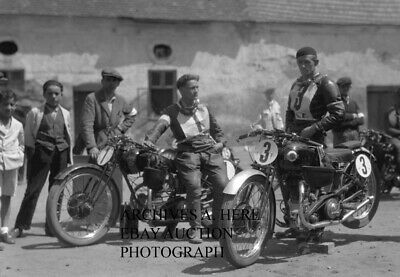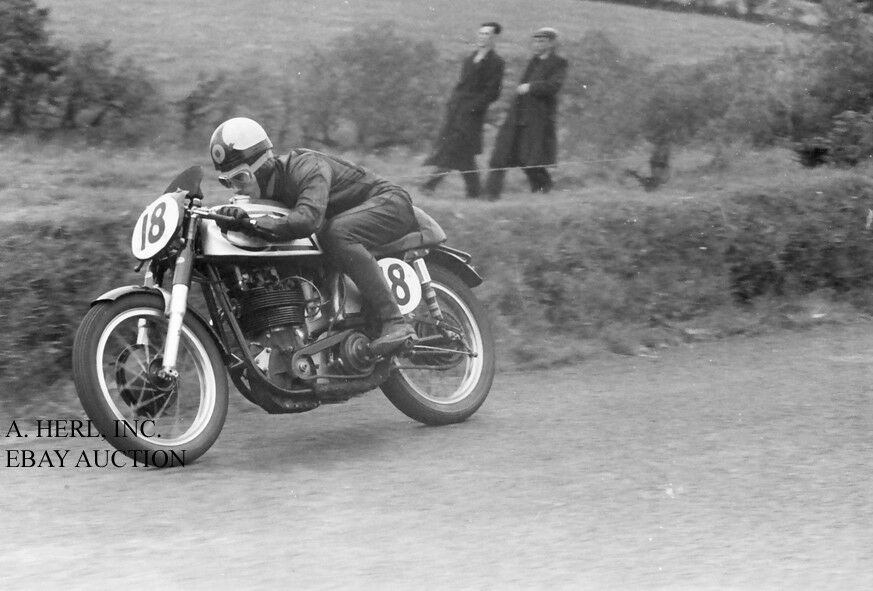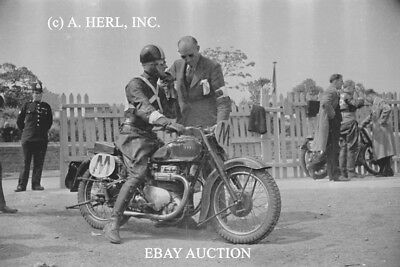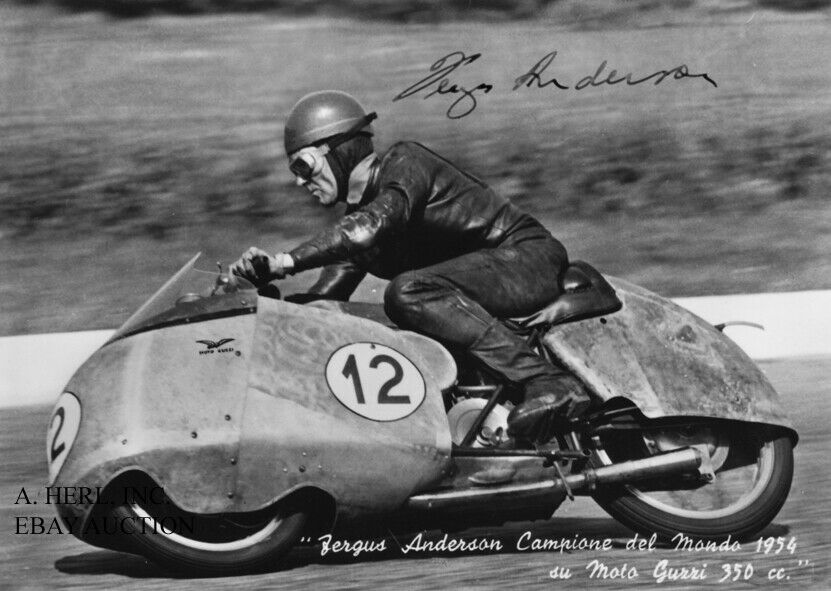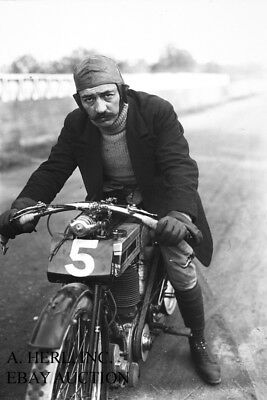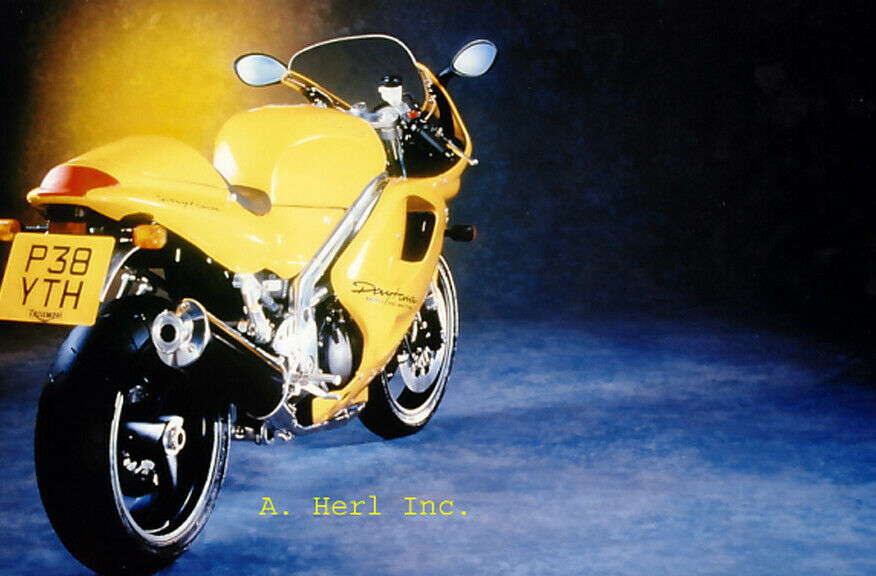-40%
Rudge 500cc works racer Grand Prix racing motorcycle photo press photograph
$ 5.14
- Description
- Size Guide
Description
A superb and rare photo ofthe
impressive
500cc Rudge
.
Rudge
motorcycles were known for their incredible
innovations
in
engine
and
transmission
design
, and off course its racing successes. Their sales motto was "Rudge it, do not trudge it." Rudge Whitworth Cycles originally resulted from the merger of two bicycle manufacturers in 1894, one of which descended from the original bicycle company founded by Daniel Rudge. Rudge also produced the first detachable wire wheel in 1907 and was known for its knockoff wheels on sports cars well into the 1960s.
Selling re-badged Werners in 1909, the company went on to produce their first motorcycle in 1911.
This was a single-cylinder F-head, or IOE (inlet over exhaust), 500 cc bike. In 1912 the belt drive 499 cc Rudge Multi was released, using variable groove-depth pulleys to gain 21 forward ratios, and a top gear as high as 2.75:1. (The Zenith Gradua and 1907 FN 244 cc single used a similar system.) In 1913 a 750 cc Multi was released. In 1914, a Multi won the Isle of Man TT . In 1915 a 1000 cc using a Jardine four speed gearbox was released, followed by a 1000 cc Multi. In 1923, they introduced an in-house manufactured 4 speed gear box to replace the Jardine gearbox, and Multi production ended. It was called a Rudge Four, because of the four speeds and four valves, not four cylinders. This single cylinder 350 cc machine showed markedly superior performance to the competition on release, having more power than its 500 cc predecessor. Rudge engineer, George Hack, is said to have taken his design idea from the four valve head Ricardo-Triumph Special of 1921, a one off machine. He designed a four valve head for Rudge and in 1924 they produced their first four valve cylinder head on a 350 cc engine. The valves were arranged in parallel, and were not radial. In 1925, a 500 cc version with linked front and rear brakes appeared, and the big end bearings were now fed oil through the crankshaft pin. The old 350 cc was dropped in 1926. For 1928 Rudge motorcycles were fitted with saddle tanks, and 8 inch internal expanding drum brakes. Stanley Glanfield designed a Rudge for dirt racing, marketed from 1928 as the Glanfield Rudge. In 1929 Graham Walker won the Ulster Grand Prix averaging over 80 mph. This prompted the release of the Rudge Ulster, as well as a JAP engined 250 cc and parallel 4 valve 350 cc. The
Ulster
was one of their most famous models. Rudge bikes also finished first, second and third at the 1930 Junior TT using prototype radial 350 cc 4 valve engines. They also took first and second in the Senior TT. The road bike engines were changed to dry sump lubrication. The JAP 250 and the parallel four valve 350 cc ended production in this year. In 1931 Rudge released its first 250 cc and 350 cc road machines with the radial valve layout. TT Replicas were available in 350 cc and 500 cc. The parallel valve 500 cc was also available in Special and
Ulster
models, the
Ulster
now having a 100 mph guarantee. First and second were taken in the 1931 Lightweight TT, and in 1932, second and third. A radial head 500 cc was produced for 1932 only. A 250 cc TT Replica was built, and the road bikes were fitted with proper oil bath primary chains, and a stand that could be operated "with just one finger". With the depression biting, 1933 was the last year of production for dirt track bikes, and the TT Replicas. The
Ulster
500 cc was fitted with a "semi-radial" (parallel valves with radial ports) cast iron head. For 1934 the Ulster had its head cast in aluminium bronze, and a radial 4 valve 250 cc Sports was released. Rudge motorcycles took the first three places in the 1934 Lightweight TT. A two valve 250 cc was produced in 1935, and in 1936 the last of the radial 4 valve 250 cc model were produced, while round tube forks were introduced on other models. In 1937 the valve gear became fully enclosed on the 500 cc models, but finances were bad and Rudge was bought by EMI, and production was interrupted, being moved to Hayes, Hillingdon in Middlesex. A 250 cc 2 valve Sports was released in 1938, and for early 1939 the
Ulster
had an RR50 aluminium cylinder head. Production ceased in December 1939 in order to convert to radar production for the war effort.
This is a very nice and very rare
non period
photo that reflects a wonderful era of 1930s motorcycle history in a wonderful way. This is your rare chance to own this photo, therefore it is printed in a nice large format of ca. 8" x 11" (ca. 20 x 27 cm). It makes it perfectly suitable for framing!
Shipping costs will only be $ 7.00 regardless of how many photos you buy. For 5 or more photos, shipping is free!
(Note: A. Herl, Inc. does not appear on photo, for ebay purposes only)
No copyright expressed or implied. Sold as collectable item only. We are clearing out our archives that we have gathered from various sources.
All items always sent well protected in PVC clear files
and board backed envelopes.
We have photographs that came from professional collections and/or were bought from the original photographer or press studio! They are all of professional and excellent quality.
After many decades of professionally collecting photographs and posters we are clearing out our archives. They make the perfect gift and are perfectly suited for framing. They will look gorgeous unframed and will be a true asset nicely framed with a border. They are a gorgeous and great asset in every home, workshop, workplace, restaurant, bar or club!
First come - first served. And you can always contact us for your requests. Please ask any questions before the auction ends.
